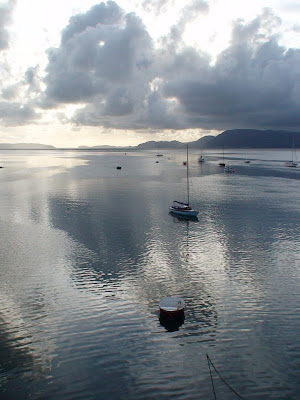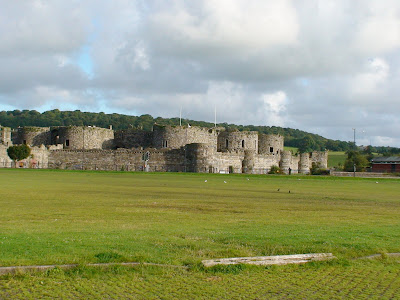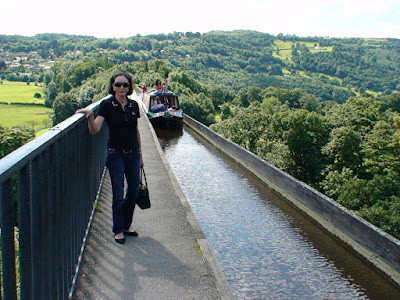Wales of a Time
WALES OF A TIME
My wife sleeps easily in the car but she woke up quickly as soon as we entered Wales in view of my tongue-twisting and gullet-clearing in my attempts to pronounce roadside signs in Welsh. I discovered that Dim in Welsh means “No” and consequently found its application in many places - where I couldn’t park or couldn’t enter or couldn’t spit, a virtual impossibility when trying to say it in Welsh! Try to say something starting with a double-l and see how far you get, and I will make sure I am not standing too close to you! I drove along thinking aloud of all sorts of dim associations, some decidedly witty, I thought, till at last my wife told me to desist. Once a dim wit always a dimwit I surmised, but held my tongue!
We slipped quite easily into Wales on the roadway that passes Chester, for nothing of the countryside changes and then suddenly and dramatically, it changes to mountains and coves, almost as though an earthly sleeper has suddenly risen. We circled past Colwyn Bay, the cheek-puffing Llandudno and then crossed the bridge into Conwy with its massive castle ruin where we stopped for a coffee and a stroll. A steamer was in and disgorged its passengers onto a wide quay where the seats were full of Darby and Joans getting their tongues around Welsh with the same ease as which they attacked their ice-cream cones. “We do like to be beside the sea-side” came the tune from a fairground barrel-organ and it seemed to sum up everyone’s mood. When the sun is out, there is reason to shout, especially when you are at the seaside.
We raced past Bangor on a super highway, with me giving only a brief rendition of the ‘loverly time we had, the day we went to Bangor’ and crossed the Menai Bridge, which looked like the drawstring on an archers bow, and found ourselves on Anglesey. (It was not the last we were to see of the construction work of Thomas Telford) We had friends in Beaumaris and we followed a coastal road, constantly getting glimpses, across the waters of the Menai Strait, of the mountains of Snowdonia. From time to time the sun shone down through black clouds, like blonde streaks in dark hair, while the sea was an appropriate slate colour, oily and unwelcoming. Our friends however, provided ready compensation with steaming tea and Welsh cakes, and not a word of boyo between them.

Beaumaris Bay
The next morning early, as is my bent, I walked in to Beaumaris, the main town on Anglesey. Again, save for the newsagent, I had the town to myself. I walked along the seashore and looked at the bay of mud, little yachts on twin keels looking like nautical stilt-walkers, while others simply lay on their sides, amid a vast crop of seaweed, like a lazy dog. I bought a newspaper and wandered along a small pier and dangled my feet over the edge, above the dark water. Like Otis Redding I sat and watched the tide rolling in (yes, and later I watched it rolling out again!) but I was hardly wasting time, watching a magnificent sunrise and having a lot of eye contact with the huge seagulls that came to me purely for company, as I proffered them no food. The size of the seagulls strikes you immediately you get to the coast in Great Britain for they look as though they have either been on steroids, or have grown so large from eating all those genetically modified chips of which the British are so fond. I started to read the newspaper but then thought the better of it. I could read that paper anywhere, yet the brightness of the new day was unique and with a distinct change in the light, the water suddenly looked bluer as I gazed towards Puffin Island in the distance. Later I wandered across a huge grassed area to Beaumaris Castle, with its low parapets and stubby keep, more maudlin, for lack of a fight, than menacing. It was ‘the perfect 15th century castle’ my guidebook told me, with fourteen layers of defence before you captured His Lordship. Now only a pair of swans and their grey cygnets patrolled the moat while a cluster of pigeons manned the battlements.

Beaumaris Castle
Our friends lived in a seventeenth century old converted soldier’s barracks, with low beams showing the axe-marks of the woodcutters and the hooks which had been placed in the beams to hang clothing and gear. Despite the plush carpet and the superb decor, the creaking of over 300 years of habitation gave it all a decidedly romantic association. There was all that history in this little place, the swinging hammocks, the snoring soldiers and the privates coming home late from the pub, trying to avoid the Sergeant-Major’s notice. Here men had crept about, just as I did to when I had to go to the bathroom in the middle of the dark night! The bathroom, incidentally, included a magnificent claw-foot bath which I imagined had once belonged to Marilyn Monroe for, I certainly envisaged her in it, all en-bubbled, pouting her lips, and singing “Boop boop e doop, just for me!
We travelled via the wonderful valley into which Betws-y-Coed is jemmied, and went on to Blaenau Festiniog and down the cold, dank slate mines in a little train that had all the properties of a “Wild Mouse”. We often associate ‘burrowing in’ with warmth, but there was none of it here for it was just miserably cold. In this underworld there was no Dante’s inferno, just a numbing cold that found all the joints and crannies of the body, and took up lodgings. How awful life must have been ‘then’ when the heavy pieces of slate were mined by a gang who seldom saw daylight, and were paid what we now see as ‘slave wages’. Slate waste was everywhere, a landscape of grey with only the distant hills providing some relief for the eyes. Tom Jones was clearly singing about a different part of Wales when he sang of the “green, green grass of home”! Few slate miners lived beyond the age of forty, their lungs grey with dust, the future for their families also grey and bleak, forever in debt to the ‘Company store’. Most found deliverance in religion and singing, those massed choirs for which Wales is so rightly famous. I found it surprising that more did not find their outlet in rebellion!
From BF we travelled to a marvellous bit of folly, Little Italy by the sea, in the shape of Portmeirion, a must-see piece of whimsy which is right up there with Disneyland. In 1926 a rich loon, Clough Williams-Ellis decided to build a slice of Italy on a Welsh hillside beside a coast that when the tide is out, looks like a scene from Lawrence of Arabia, so large is the sand-bank. The task was only finished in 1976 when he was 90, so he lived to live out his dream, and I must admit that it is all quite spectacular and hugely appealing. Where else but in Italy – or Las Vegas – can you see 10 Bryn Terfel look-alikes wandering around an Italian village in knickerbockers and Pinocchio hats, belting out Funiculi, Finicula in the piazza, the grotto or beside the Campanile? Suddenly we were on the Welsh Amalfi, with cappuccino and limoncello at our call. All the buildings were meticulously done with great domes and arches, shops and arcades that looked decidedly Italian until you see Dim Cwn (No dogs) or a sign pointing to Y Pentref (The Village). There were beautiful gardens and lakes and a snooty hotel where the caviar and cigar set were all terribly ‘pip pip’, English rather than Welsh. We were told that episodes of the television series The Saint and Prisoner were filmed here, and it didn’t surprise us at all. In the world of fantasy, the surreal is just another everyday occurrence!
We drove through pretty countryside to Caernarfon Castle on the River Seiont where it meets Menai Strait, a huge grey stone place which looks like a castle should, and its turrets, keep and drawbridge sets every boy’s heart, both young and old, beating a little faster. It was here, in 1969 that the investiture of Prince Charles as the Prince of Wales took place and was televised around the English speaking world and in the remnants of Empire. In keeping with the job description, Prince Charles also gave part of his speech, a small part, in the Welsh language which greatly endeared him to his subjects. Caernarfon is a mighty castle with a quaint town in its lee, and dates from the 13th Century. Outside its walls is a fine statue of arguably the greatest Welshman, David Lloyd George, the original “Welsh windbag” and only ever Welsh Prime Minister of the United Kingdom, whose local constituency was Caernarfon Boroughs.
We spent a day exploring Anglesey, a vast green shagpile of an island with dark forests, broad bays and hidden coves, sprightly villages and all overlooking the dragon’s tail-like mountains of Snowdonia. On the clearest of days, with the sort of rippling breeze that the yachties love, we saw a regatta with shore-strickened Commodores, Captains and Admirals, flags raised and lowered like a lavatory seat, and a booming gun which scared the dogs and seagulls. I walked up a nearby hill to capture the scene and looked back on a wonderful seascape with the sea a deep blue, and a fleet of fleas skipping over the bay. We drove past a place where giant flying boats were manufactured in the in-between war years, but now only the vast tin hangers remained. I could however, still ‘see’ them battling spray and spume to lumber, somewhat gracefully, into the air. We stopped at a dovecote where centuries ago, friars had cultivated fliers, and then plucked them for their pigeon pies. For our own lunch we stopped at Red Wharf and had a Ploughman’s Lunch at the wonderfully sited and named, Ship Pub. We sat with our pints and watched a fellow luncher, who had come by boat, suddenly realise that the tide was going down the plughole, and pushing his family laden boat through the mud to reach the receding sea, gave mirth to us all. Past Holyhead, the countryside with cliffs to the sea, the sloping fields full of straggly sheep, a lonely lighthouse and the white cottages, took us back to Ireland, just a few hours away across the Irish Sea. Anglesey had its own innate, restful, beauty and we were fortunate to see it at its best.
We farewelled Wales at the pretty town of Llangollen, a pretty place although quite overgrown with scrambling tourists, and people holding dogs on leashes. The hills rose behind the town and the River Dee rushed over rocks as it scuttled down the valley and at the nearby picturesque railway station, people stood in pods, awaiting the arrival of a steam train. Elsewhere, others waited their turn to board narrow-boats for a horse-drawn trip along the famous Llangollen canal. Railways and canals, the highways of the industrial age, seemed incongruous in this narrow valley, and yet here again, man had triumphed over nature to allow boats and trains to go where they really had no place to be. A few miles beyond Llangollen, we stopped to see Thomas Telford’s late eighteenth century masterpiece of engineering, the Pontcysylite Aquaduct on the Shropshire Union Canal, a canal in the sky over the River Dee, fifty metres below. For nearly a hundred years from 1793 the canal boats carried vital ores and slate from Wales, and coal and goods on the return journeys, on networks that together with the railways made Britain great. A hundred miles inland there were wharves and docks, canal pubs and shops, like the highway service centres of today. Now mainly tourists ply the waterways. The men who built the canals, who cut through hills with only picks and shovels, who dug great tunnels and built viaducts, their toil and their hardship is given nary a thought as the narrow-boat cruises through the countryside, people in deck-chairs enjoying the scenery.

Llangollen Bridge
Wales, that part of it which we saw, was beautiful, rugged, and seemed only partly tamed. In many places we saw walkers, in stout boots and gaiters, a staff in hand and backpack strapped on, climbing great hills to find their own slice of solitude. You can still do that in Wales. In the towns there were gentler, but no less determined walkers, enjoying the shops and man made things. You can do that in Wales too, for it is a place rich in diversity and space to enjoy it all. We did not see a rugby ball, a leek or a dragon, or hear the people on the terraces singing “Men of Harlech” and yet we felt greatly enriched by our brief journey. “But that was nothing to what came out from the sea-caves at Criccieth, yonder” I could hear Robert Graves saying to coax us back. He need not have bothered for we will return boyo. The beautiful South and the valleys await us. Later, when we crossed from Wales back into England, it was appropriate that we did so over a bridge over a deep valley. I hummed the warm Welsh song of greeting, We’ll keep a Welcome over and over again, for a long way into Shropshire.
All photos courtesy and copyright of Winfred Peppinck.
Winfred Peppinck/wandering freditor is the Tales of the Travelling Editor for Wandering Educators.



















Dr. Jessie Voigts
Winfred - your trips are so very lovely - you've got a way with words that makes me want to follow in your footsteps! master wordsmith, indeed. thanks!
Jessie Voigts, PhD
Publisher, wanderingeducators.com